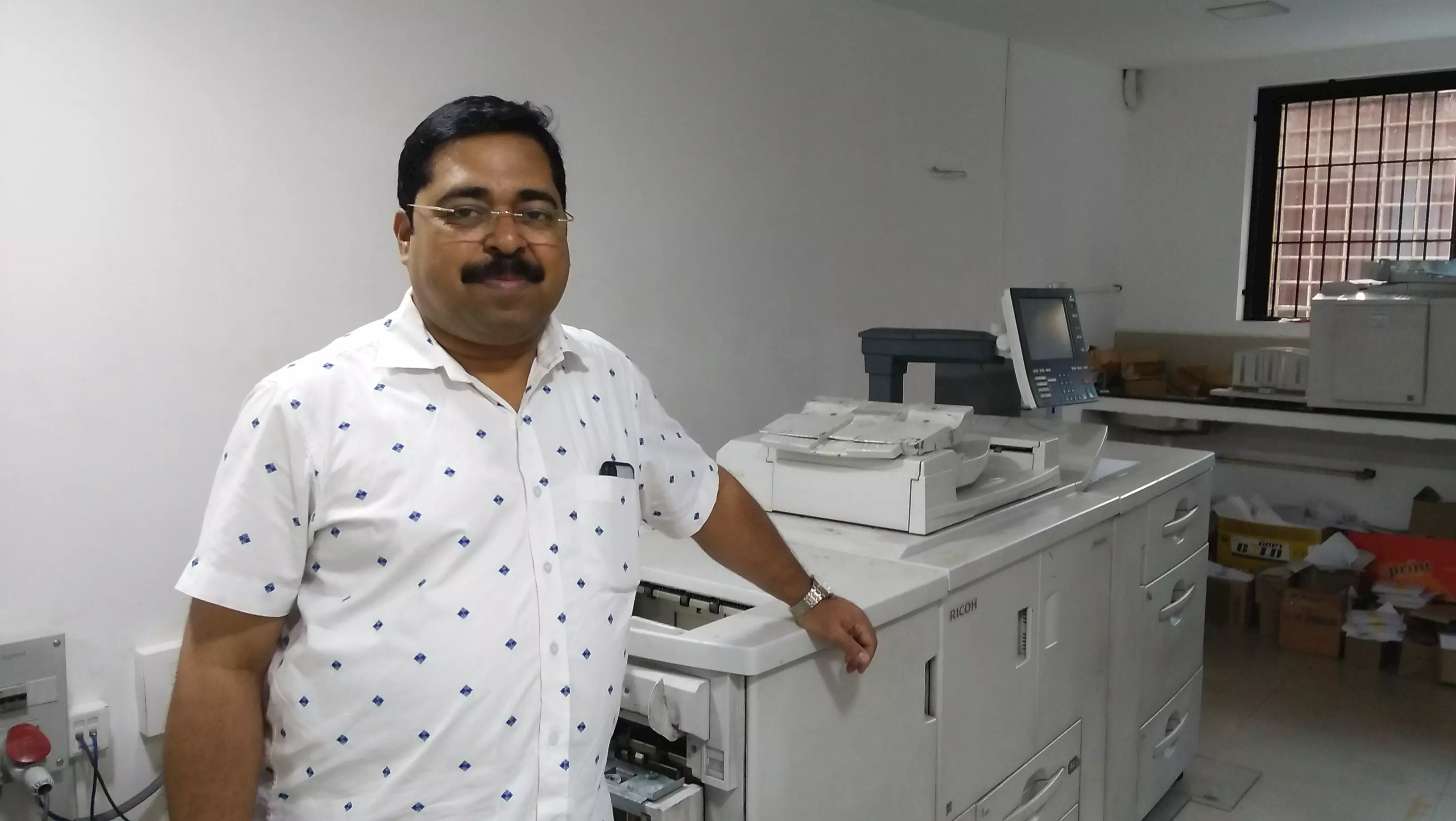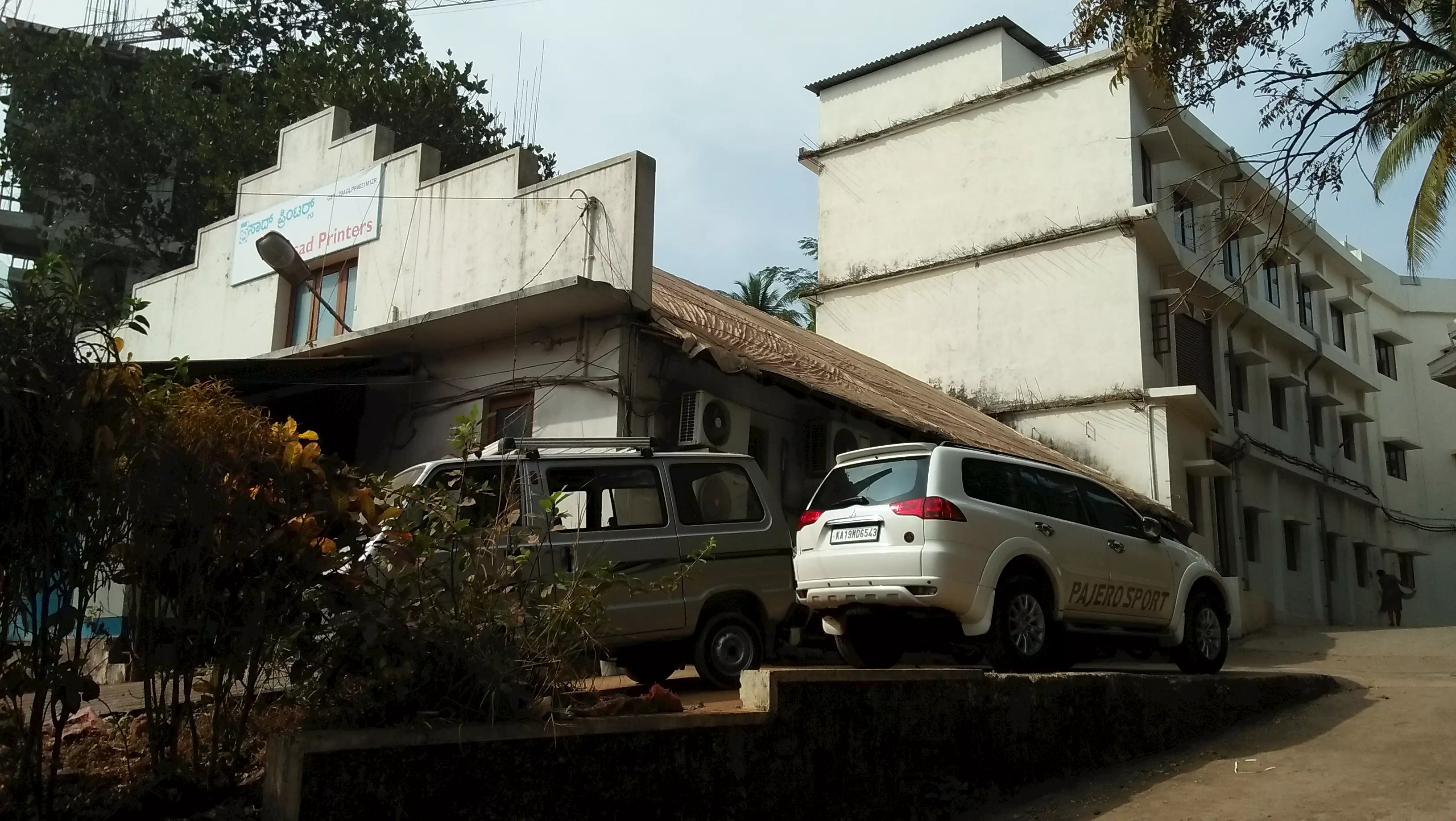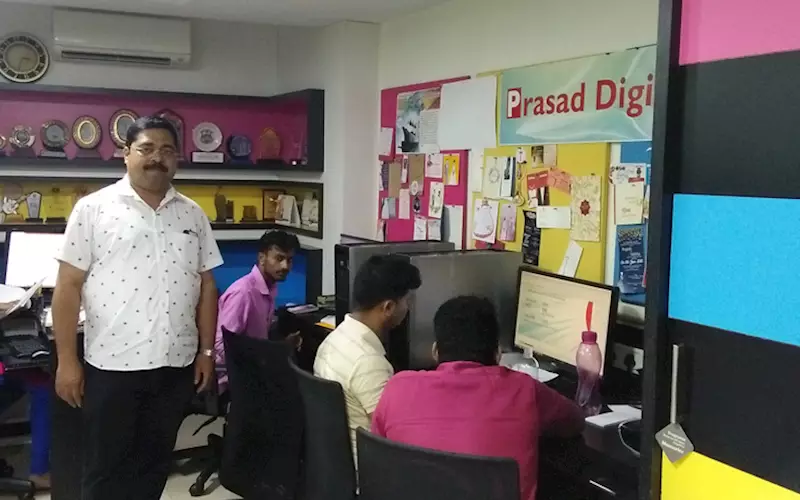A humble family press in Kulshekar
Roshni D’souza and Sudhanva Prahaladraja of Manipal Institute of Technology spent time with Praveen Patrao in Kulshekar, approximately 8 kms from Mangalore city to understand how the Patrao family copes with the offset and digital ops
26 Apr 2019 | By PrintWeek India
How did you get into print?
In the early 1960s, my grandfather started a printing press with two of my uncles who were working for a press. My father, Thomas Patrao who was good in marketing, joined his brothers. Later, after marriage, all the brothers separated and started their own printing presses. At one point of time, the Patrao family had five printing presses. Except for our press, the rest of the presses were closed because my cousins did not want to continue in the printing industry.
How was Prasad Printers born?
We started Prasad Printers in 1972. In those days, this Kulshekar belt was a no-mans land. My father was technically proficient. He knew all about machines. We started in a humble way. As the press was attached to my home, during my early days, I used to spend time with the machines on Sundays and during my vacations. I was fascinated with the variety of jobs getting printed on those letterpress machines. It was a pleasure to see the mixing of colours. Our staff members were really skilled. You must understand there were limitations in technology.

So, you learnt, on the job?
Yes. I learnt the trade from my father, and print technique from the senior workers.
You said you were at the press in your childhood. So along with your studies, you also managed the press?
I started learning typesetting when I was in the fifth standard. I was ten years old, then. When I was 12 years old I knew to work on all the machines. We could not print A2 size jobs on our treadle machines. When I was studying during my pre-university days, we purchased a cylinder printing machine. Immediately after my studies, we ventured into offset printing. My studies were never affected. It was my duty. But printing was my passion.
And you learnt to operate it?
Whenever a new machine enters my press I learn to operate it. I have persevered with this habit, to-date. My father was there to guide me till his sudden death in 2003. My father was involved in the marketing of our print collaterals and I used to look after the production.
Is this the same building where your press was situated?
Yes, one part of our house was the press. My present office was the composing room. The neighbouring room where you see CTP functioning was our machine room. Gradually, the press took over the house and eventually, we had to build a new house.

How old is your press?
The press was started in 1972. So it is 47 years old. This building is older. It is 70 years old. Due to our good maintenance, it’s looking fine. We will retain it for a few more years. (He sighs) This building is of enormous sentimental value to my mother, Letitia Patrao.
Is your mother involved in the press?
Sure. My mother who is aged 76 is my guiding force. In fact, our Prasad Printers is a family press.
How so?
In the mornings, my mother goes to the digital unit which is in the city. In the afternoon, she comes to the offset unit plus the post-press department. My wife, Felcita is in-charge of the digital unit. My son, Prasad who is studying E&C in St Joesph’s Engineering College has joined his mother at our digital unit after his class hours.

Prasad with Felcita at Prasad Digitals
How do you manage both the conventional and digital presses?
Offset and digital units are complementing each other. We are not too keen to produce huge volumes. But we are concentrating on producing quality jobs with reasonable margins. My responsibility in Prasad Printers. And at Prasad Digitals, it is all about learning newer technology, analysing our requirements and procuring the right equipment. The finances are handled by my mother and by my wife.
When did you start Prasad Digital?
To commemorate the 40th anniversary of Prasad Printers, we started Prasad Digitals in 2012. It is a seven-year-old young firm and it is going great.

What is the buzz about the industry?
See, when we talk about our industry, I perceive that every day this industry is changing rapidly. It is on a fast track. The digital segment is so innovative that before you take back your investment, a new innovation has already been introduced. It is a tough competitive field. I presume that we require a lot of patience, understanding of the technology before adapting it. Otherwise, we will burn our fingers.
What about offset?
The offset segment is equally competent. Unless and until we have the best machinery and technology, we may not be able to create innovative jobs. Value addition and innovation is the difference between you and your competition.
Any big brand whose job you are doing on your press?
As on now, I have not done any jobs for international brands directly. But of course, I feel we are capable of handling any pedigree job. I have always adored one particular company Amul. This is one Indian company that has bought the concept of ‘the white revolution’ and has raised it to international levels. Irrespective of all the constraints it has shown to the world, it can reach the highest scales if you have a vision. The concept of cooperative movement what Verghese Kurien has bought to the world is still vivid. I am sure someday, I will be able to print for them.
Have you approached them?
No, not yet. Now we have all types of machines for packaging and commercial printings. We have to look at corrugation next. Our next focus is on that segment.
What is the strangest job you have ever created?
I can’t pinpoint a particular job. Every job is challenging for us.
Please explain, why so? If you take any job lightly, it will bother you, and you regret it later. And so, right from the initial stages, we have to be very careful. In my college days, I remember, we had to print a two-colour drama poster. The fonts used were five-inch wooden types in Kannada. It was printed on our Japanese cylinder press Yoda. The client was very particular about the reproduction of colour. It was a two-colour job and I had a single colour machine. We had to run the job twice. Maintaining the royal blue and deep red colours on all the copies was very difficult. It was a very challenging job, especially when one considers the technology of those days.
In those days what were the constraints you had?
The biggest constraint for me? I was very young.
How did you learn?
I learned from my mistakes. Technically, I had no guidance. It was in the early 1980’s, the printing industry started growing rapidly due to the involvement of computers. I could not attend big exhibitions because I had to focus on my studies. We used to depend on others for information. Once, I remember I ordered a laminating machine from Amritsar and the machine was on its way. A very senior printer misguided me saying that for gloss and matt laminating you need to have two separate machines. I enquired with the company. On cue, they clarified my doubt and showed me how gloss and matt lamination could be done with the same machine.

Have things changed?
Today, things are different. The only reason is the internet. If I want to seek information about something, we get it from Google. This was a major constraint in those times. Today we are lucky to have so many print exhibitions, seminars etc. It was only by attending exhibitions, seminars and conferences that our company grew technically.
Have you felt the influence of electronic media over print media?
Yes and no. Some of the jobs like ledgers, registers, bank stationery have been wiped out. At the same time, commercial jobs are raising. Many print related magazines I read say print is sustainable. Statistics show that books which were declining in the past few years have seen a sharp rise.
What is your personal experience?
As for me, in the last couple of years, we have progressed immensely. In order to survive, we have to concentrate on quality, speed and technology. We need to update. Which is why, we started a digital printing unit to meet every demand.
What is the uniqueness of your press?
We are known for time management and quality product. Each and every time, we strive for optimum result.
When you see a print job as a consumer, have you felt Prasad Printers could have done better?
Yes, many times. Right from the designing to colour combinations, selection of paper and type of finishing. At times we educate our customer. When I go to supermarkets rather than the product inside the packaging, my concentration is on the wrapper of the product and print.
Are your printers technically skilled?
The tragedy in this part of our country is we do not have very good skilled workers. We do not get people to train them. It’s through a trial and error method we learn. Some of my employees are really good in learning the job, we give them training also. They learn from the service and print engineers who visit us, to check our machines during routine maintenance.
Which is the trickiest colour you have printed?
The most complicated colour that I have printed is violet, indigo, deep blue and royal blue in a single sheet and single pass. It was a very tough job, but we did it to our customer’s satisfaction.
Any mistake you made in print?
Once, we used an old file to print a monthly magazine. We had to discard the entire lot.
Oh no.
Initially, when we started mono carton jobs on a single colour press, we clubbed three jobs together with different colour schemes, to save on time and plates. It was an enormous loss, as we could not match the colours. But then we reprinted the job separately and succeeded in achieving the quality. One thing what I understood from these experiences is, we should work with an open mind. If your mind is preoccupied you tend to make mistakes. Every mistake was a lesson for me.

Will your son Prasad Lester lead your press after his studies?
I have no plan for him. Like you young students, he has to plan his own future. From his childhood, he has shown a lot of interest in our press. He spends most of his time with me in the press. Nowadays, he joins me during conferences and exhibitions. Whenever we make a plan for new machines, it’s he who get me the comparative details of the machine or process. He has tried his hands on all the machines. My sense is, he has an inclination about press. But as I said, I will never entice him, he should come on his own.
Any prominent press you have visited?
A few years ago, I had to print a particular job which I could not produce here, so I visited MTL in Manipal with my mother. I was fascinated by the workflow, cleanliness of the shopfloor, the overall environment etc. They have always stood tall in our industry and I admire them. Once we had an opportunity to do a job for MTL. I was very impressed with the professionalism of their QC officer who came to our factory to inspect the job. Lots of good learnings.
Other than an MTL?
I admire Silverpoint in Navi Mumbai. I was there to buy a machine. I spent three days and was amazed by the culture they follow, from the top management to the smallest worker on the shop floor. They are friendly, they are complementing each other in their work, they are very meticulous and they are innovative. The professionalism and humility are in their culture. Above all, the innovative jobs they produce, are ahead of the time.
Prasad Patrao

Prasad (l) and Praveen Patrao
Free time: I spent my free time in my digital unit. I work with my colleagues as a normal employee. I learn from them plus I teach them what I know. I spend my time in the commercial unit, too. I am very fascinated by digital print technology.
Role model: My father, Praveen Patrao. I have learned a lot about print techniques from him. He has taught me tiny details. Whenever I make a mistake, he used to explains me how it happens. He makes sure that it is not repeated. He is a perfectionist. He works along with our employees. He has helped me to develop leadership skills. My studies complement my profession. My grandmother is my other teacher. I have learnt from her on how to tackle every situation of life.














 See All
See All